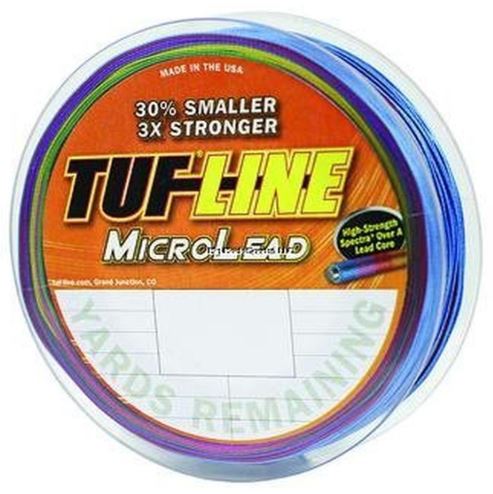Even with lead core line, anglers must fight that pesky water resistance known as drag. The faster you troll, the higher the drag against your line and the less depth you’ll achieve. Though Tuf Line MicroLead isn’t as heavy as Tuf Line Lead Core, its thinner diameter creates less drag. A strong Spectra braid protects the lead core and triples the strength of the line. Jump into the following review to learn the benefits and drawbacks of a quality micro-lead line.
Tuf Line MicroLead Trolling Line
Product: Tuf Line MicroLead braided fishing line.
Overall Ranking: 88 out of 100.
Price: Higher range.
Company/Owner: Western Filament, Inc.
Website: Tuf-Line.com.
Intro To Tuf Line MicroLead
View MicroLead On Amazon
Tuf Line MicroLead Spools, Specs, & Features
MicroLead Spools
Tuf Line manufactures its MicroLead line in tests of 15. 18. and 27 lbs though its actual breaking strength is considerably higher. Being slightly thinner than monofilament line of equal strength, it’s available in spools of 100, 200, or 1,000-yards. Check the complete details in list form below.
- 15, 18, & 27 LB Test x 100, 200, or 1,000 Yards – Multi-colored
Specs Of Tuf Line MicroLead
As they do with all their products, Tuf Line provides full specifications of line strength and diameter. Another justice Tuf Line does for anglers is to give the true breaking strength of all their lines. This specification along with the standard numbers are visible in the following list.
- 15 LB Test (49 LB True Break): 0.534 (MM) 0.021 (IN) – 20 LB Mono
- 18 LB Test (53 LB True Break): 0.585 (MM) 0.023 (IN) – 20 LB Mono
- 27 LB Test (63 LB True Break): 0.611 (MM) 0.024 (IN) – 25 LB Mono
Main Features
Similar Sink Rate At A Thinner Diameter
In their MicroLead label, Tuf Line reduces the line diameter which means there’s less lead. The line is thirty percent smaller than their standard lead core label. This, of course, means there’s also less weight to the line but there’s also not as much drag. Tuf Line claims that because the thinner line has less resistance against the water, it’s able to achieve the same depth as their standard lead core line.
Spectra Fiber Braid Triples The Strength
Colored Metering & Sink Rate Formula
Like their standard lead core line, Tuf Line MicroLead features a metered color change every ten yards. The pattern of colors repeats itself after 100 yards, allowing anglers to judge their lure depth while trolling. Tuf Line provides a sink rate formula with the understanding that it’s never a precise science.
Trolling in water that has no current, a one-ounce lure will achieve a depth of 6 to 6.5 feet per color. That comes out to about 1.25 feet for every 2-yards of line out. This formula works for trolling speeds between 1.5 to 2.5 mph and can be adjusted by lure weight. Every 1/4 ounce you add or subtract to your lure will lower or raise the depth by about a 1/4 foot.
Quality Braiding In The USA
One of the main reasons anglers prefer Tuf Line is their high standards in manufacturing. Tuf Line, along with the longtime backing of Western Filament, produces only the highest quality of fishing lines. They manufacture all products in the USA using the newest technology in braiding machines. Expect the best when you go with Tuf Line.
Check MicroLead On Amazon
Pros & Cons
Pros Of Tuf Line MicroLead
With a line that’s both thinner and stronger than typical lead core lines, anglers can drop down in gear size. Unlike standard lead core lines which are thicker than their monofilament equivalents, MicroLead comes out thinner. That means you’ll get more line on your reel and you can use smaller equipment. With lighter rods and reels being the latest trend, MicroLead is useful indeed.
Disadvantages
Though Tuf Line claims their MicroLead line achieves the same depth rate as standard lead core lines, anglers report a different experience. It doesn’t seem to be too big a deal because adjustments to lure weight can help equal things out. The line is definitely strong enough to take a heavier lure.
There is at least one report of the lead leaking through the Spectra fiber, though most of the angler feedback is extremely positive. Finally, Tuf Line doesn’t manufacture many different diameters of MicroLead due to the thin nature of the line.
Best Fishing Use/Application
MicroLead performs best while trolling freshwater rivers and lakes or saltwater inshore areas. Its limitations in larger tests make it unsuitable for handling anything too big but salmon, striper, lake trout or bass are all target species. Anywhere you might troll (within the specs of the line) while fish hang deep is right for MicroLead line.
Tuf Line Customer Support
The Final Wrap Up
88 out of 100 anglers approve of Tuf Line MicroLead fishing line
Though Tuf Line MicroLead is thinner and stronger, most anglers still prefer the heavier weight of standard lead core line. In the right situations, that score may very well surpass the rating of Tuf Line Lead Core. For lighter applications and slower trolling, MicroLead may be the better choice between the two.
If you have any questions or experiences using Tuf Line MicroLead, please place them in the comment section below. Our fellow anglers appreciate reading and learning all they can, and your feedback goes a long way. Thanks again for catching another review and tight lines until next time. FishtFight.com.

